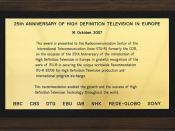Considering the growing population that is being submersed into new media technology, one cannot help but notice the growing wave of high definition television, herein referred to as ÃÂHDTV,ÃÂ entering consumer markets and becoming as much of a household staple as apple pie. The following paragraphs feature a look at how HDTV is increasingly becoming the number one consumer choice for television, and how television networks and cable providers have reacted to the increased demand for HDTV broadcasts. The analysis contained within will focus on the progression of HDTV through the four phases of technological development, while also concentrating on the present and future impact of HDTV on consumers, the US government, and the world.
Phase One: InnovationThe HDTV consumers know of today was first developed by a super-group of television and electrical manufacturing companies known as the Grand Alliance (CEA). They first introduced a form of HDTV in the 1990ÃÂs in response to the Japanese broadcasting company NHK, and their development of an analog form of HDTV (CEA).
The large difference between these two HDTV technologies was that the HD media and hardware being developed and tested by the Grand Alliance was in digital form (CEA).
Recent innovations have lead to the creation of HD television sets that are outside of the traditional CRT spectrum. These television sets include liquid crystal displays (ÃÂLCDÃÂ), plasma displays, and digital light processing (ÃÂDLPÃÂ) displays. These new HDTV sets were brought in to combat several problems consumers had, with the most highly regarded being quality, affordability, efficiency, and size (Ou). CRT displays tend to be quite large due to the traditional cathode ray tube found inside the HDTV set, and can also consume more power than LCD and DLP displays (Ou).
Plasma displays provide an excellent picture, but at a high purchase, electrical,



WOW!!!
I have nothing negative to say.
Good work...excellently researched, well developed. Sources are included thats a good thing and refers to literature.
Conclusion a bit too short since u have four phases and a more lenghtened conclusion can be drawn from the phases.
Good Overall!!!
0 out of 0 people found this comment useful.